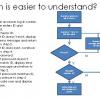|
|
How to Build a CM and ALM Strategy Joe Farah writes that a next-generation CM and ALM strategy may seem aggressive, but it will help ensure that you're happy with the result. It will make sure that you deal with the entire problem domain from an organization perspective, rather than just the part your team is traditionally comfortable with.
|
|
 |
Four Agile Tips to Eliminate Rework in Application Development Your applications need to meet business needs, overcome complex processes, and provide instant results to customers. And, ideally, they’ll require minimal rework on your part. The first step to success is requirements definition. Here, Filip Szymanski offers some tips from agile methods that will improve your requirements—even if you haven’t otherwise adopted agile.
|
|
|
|
9 Questions You Must Ask When Selecting the Right Tool and Vendor The key to selecting the best vendor and tool is asking the right questions. The answers to these nine essential questions can mean the difference between satisfaction with your purchase and a giant waste of time and money.
|
|
|
|
Transitioning from Analysis to Design The step between specifying requirements to working on a system design can be tricky. Fortunately, the basis on which the step is made can be calculated. Paul Reed thoroughly explains how the transition should progress and offers some instructions on how to move properly through this phase.
|
|
|
|
Using Mocks to Verify Interactions In the March 2006 issue of Better Software magazine, Dan North began a discussion of the evolution of behavior-driven development from test-driven development. Here, North continues the conversation with closer look at "mocks," utility classes that, for testing purposes, pretend to be some component or service with which your object will interact.
|
|
 |
Finish on Time by Managing Scale When deciding how a user's task is to be supported in our software, we often look at possible design solutions and select one that's best for the product and the user. As the project deadline approaches, however, we might choose to dismiss some features outright. In this column, Jeff Patton suggests we try keeping more features by adjusting their scale.
|
|
|
|
Requirements-Based Development: A Software Configuration Management View It seems so obvious that we should develop systems based on requirements, and yet it turns out to be rather hard to do and thus many organizations are doing it very badly. From a software configuration management standpoint, we could perhaps leave the whole process of requirements engineering to one side and focus on the management of requirements and thus the aspects of change control and traceability. That would perhaps be unduly ducking the issue, and, of course, we can’t resist giving an opinion anyway!
|
|
|
|
The Trouble with Tracing: Traceability Dissected Traceability! Some crave it. others cringe at the very mention of it. For hardcore configuration managers and requirements and systems engineers, it is a fundamental commandment of “responsible” software development. For many hardcore agilists and other developers, the very word evokes a strong “gag” reflex, along with feelings of pain and frustration. Traceability requires work and discipline! So how does traceability add value to our business and how can we make it easier?
|
|
|
|
Product Risk Analysis Clarifies Requirements This presentation re-emphasizes that requirements are important. The difference between functional and nonfunctional requirements will be covered. Then, Product Risk Analysis will be described, along with the elements of the analysis and steps toward performing the analysis.
|
|
|
|
Modeling Practice and Requirements Models are useful in different settings in different ways. Models can test facts, ideas and understanding, simulate operation, and aid coordination between systems and people. In this column, Becky Winant lists six model patterns she has seen in practice in software development organizations, talking about where each is appropriate, and the strengths and weaknesses of each.
|
|

